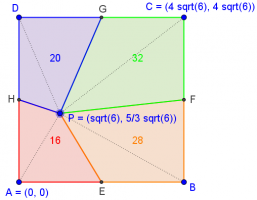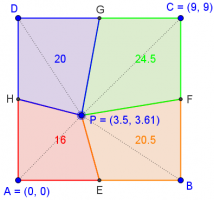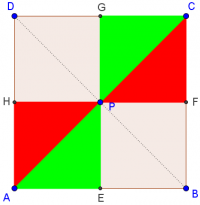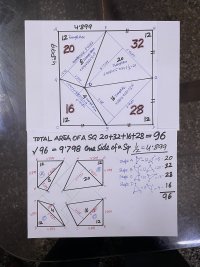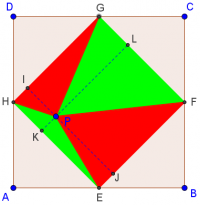That would be an interesting (though flawed) method if we were told that the sides of the squares are integers.
But that assumption is wrong; in fact, the sides are about 9.8 cm long. Your answer also does not fit the hint that was given.
(The answer in #11 is also wrong; I don't know why I didn't say so explicitly at the time. The error is in saying "32 + 64 = 98".)
Total 98 is not perfect square.
Next perfect square is 100 only.
Assumption integer is ok. And missing Area is 13 cm.
Given three portions having total area is 68. And hence Side must be more than 8.
If assumption is in decimal, the side should be more than 8.2 min because 8.2 x 8.2= 67.24
( Similarly n number of decimals can also be assumed and you can't get a single answer)
Example
8.3x 8.3= 68.89 less 68 then missing area is 0.89 Sq cm.
Similarly missing area for
8.4x8.4 = 70.56 then .. ...2.56
8.5x8.5. = 72.25 then .....4.25
8.6x8.6 = 73.96 then .....5.96
8.7x8.7 = 75.69 then..... 7.69
8.8x8.8 = 77.44 then ..... 9.44
8.9x8.9 = 79.21 then .....11.21
Upto side 8.8 cm is not practically possible because two sides of quadrant are more than half of square side.
Example. If side of sq is 8.8 and hence given two right angle sides of quadrant are equal which is 4.4 each. Hence as per the drawing the area formed by missing quadrant must be more than area of right angle triangle formed by the two sides.
Right angle Triangle area is 4.4X4.4x(1/2)= 9.68
Hence Assuming side as integer will give correct answer side is 9 cm. Area of sq 81 sq. cm and missing area is 13 sq cm.
When you are getting answer at side of square is 9, then no need to add decimals or integers with the side 9cm.

